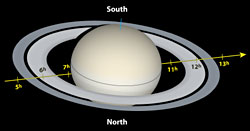
The 8.4-magnitude star follows this apparent track behind Saturn, as seen from anywhere on Earth, but the time it will reach a particular ring or gap could vary up to 10 minutes or so, depending on your location. (Remember to subtract 5 hours from UT for EST, 8 hours for PST.)
Sky & Telescope illustration by Steven Simpson.
Late Friday night, November 14–15, Saturn and its ring system glide right in front of an 8.4-magnitude star in Gemini. Observers with large enough telescopes — ideally 8-inch or larger — can watch as the star leisurely fades in and out of view behind the various rings, gaps, and the open space between the rings and the ball of Saturn itself.
Skywatchers with the best view of this rare event are those living in western North America. They’ll be able to see the star enter the ring system Friday evening and finally leave it 7 hours later.
For eastern North America and most of South America, Saturn is higher in the sky during the initial stages; the star should reach the Cassini Division in the rings shortly before 1 a.m. Eastern Standard Time. These viewers can see the star coast right up to the planet’s limb around 2 a.m. EST, but dawn will prevent them from seeing it come out the other side.
European observers are limited to watching the star just enter the ring system as morning twilight interferes.
Sky & Telescope contributing editor Thomas A. Dobbins notes that two British amateurs witnessed a similar occultation of a 7th-magnitude star in 1917. Using 5-inch and 9-inch telescopes, they could dimly see the star behind the outer ring (ring A), making that ring seem translucent. But they failed to see the star when it was behind the brighter B ring.
Titan Too!
Just one day before it encounters Saturn this week, the same 8.4-magnitude star will be occulted by Titan, Saturn’s largest moon. Bruno Sicardy (Paris Observatory) describes this event on his Web site and points out that it may produce a “central flash” around 0:13 Universal Time on November 14th. Most likely to be seen from parts of South Africa, and lasting up to 10 seconds, the flash is a visible focusing of the star’s light by Titan’s atmosphere.
 0
0
Comments
You must be logged in to post a comment.